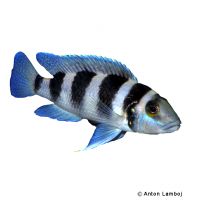Five-barred Lamprologus (Neolamprologus tretocephalus)
| Five-barred Lamprologus Neolamprologus tretocephalus | |
|---|---|
| Name | Five-barred Lamprologus |
| Name Lat. | Neolamprologus tretocephalus |
| Family | Cichlids |
| Family lat. | Cichlidae |
| Order | Cichlids |
| Order lat. | Cichliformes |
| Origin | Lake Tanganyika |
| Habitat | Rocky intermediate zone |
| Diet | Carnivore |
| pH | 7.5-9.0 |
| Behavior | Territorial |
| Keeping | Pair |
| Care Level | Moderate |
| Reproduction | Cave spawner |
| Breeding | Moderately difficult |
| Life Span | 6-8 years |
| Protection | No |
| Metric Units | |
| Size | 14-16 cm |
| Temperature | 24-28 °C |
| Hardness | 15-18 °dH |
| Aquarium | ~ 350 l |
| US Units | |
| Size | 5.5"-6.3" |
| Temperature | 75-82 °F |
| Hardness | 267-320 ppm |
| Aquarium | ~ 90 gal |
Distribution and habitat
The five-striped Tanganyika cichlids are distributed exclusively (endemically) in the northern part of Lake Tanganyika, where they live in the rock and boulder zone as well as in the rugged rock littoral over sandy bottoms.
Maintenance
The aquarium should be structured with sturdy rock structures, with caves, crevices and shelters that provide hiding places, as well as some open areas with substrate of fine sand and provide adequate swimming space.
No ammonia, ammonium or nitrite should be detectable, and nitrate levels should not exceed 100 mg/l. To ensure the water quality and oxygen content, a filter and heater adapted to the aquarium size is required, as well as lighting for the species-appropriate day-night rhythm of the animals.
Diet
In the wild they feed mainly on small crustaceans and insect larvae. The food supply consists of live, frozen and dry food. For a balanced diet, feed once a day with a high-quality dry food for Tanganyika cichlids (flakes, granules, pellets) as well as cyclops, daphnia, artemia and mosquito larvae (live or frozen)
It is recommended to feed small portions several times a day. Only feed as much as will be eaten within a few minutes. A regular and varied diet promotes health and prevents deficiency symptoms.
Behaviour and compatibility
These relatively peaceful cichlids should be kept in pairs. Especially at spawning time they behave territorial and defend their territory emphatically. Keeping multiple pairs is only recommended in a much larger and richly structured tank. These cichlids should only be socialized with other similar sized Lake Tanganyika cichlids, such as Julidochromis or Altolamprologus.
Basically, only compatible fish species with similar water condition and water temperature requirements should be socialized.
Sex dimorphism
The sexes are difficult to distinguish. Adult males are slightly larger than the females.
Reproduction and breeding
They are cave-breeding pairs and spawn at the bottom of caves. The female performs brood care, while the male vehemently defends the territory. The fry hatch after a few days and are cared for for 2-3 weeks after they swim freely.
Fry must be fed several times a day with special rearing food (e.g. Artemia nauplii). Breeding is hardly possible in community tanks, as the fry are easy prey.
Important
They have produced some different colored site variants.
The well-being of the fish should be checked regularly. Temperature should be checked daily, pH, hardness and nitrate levels at least fortnightly. Regular partial water changes are recommended, even when contaminant levels have not yet reached the upper limit. Sudden changes in water quality should be avoided. Newly introduced fish must be accustomed slowly to the water in the aquarium.
Further literature can be found in your pet store.
References
Text: Werner Winter; Image: Anton Lamboj
Source: BMELV (1998): Tierschutzgutachten - Haltung von Zierfischen (Süßwasser); RIEHL & BAENSCH (2006): Aquarien Atlas Bd. 1, Mergus Verlag; ENGELMANN (2005): Zootierhaltung - Tiere in menschlicher Obhut: Fische, Verlag Harri Deutsch
- Gemäß § 21 Abs. 5 Tierschutzgesetz idgF
